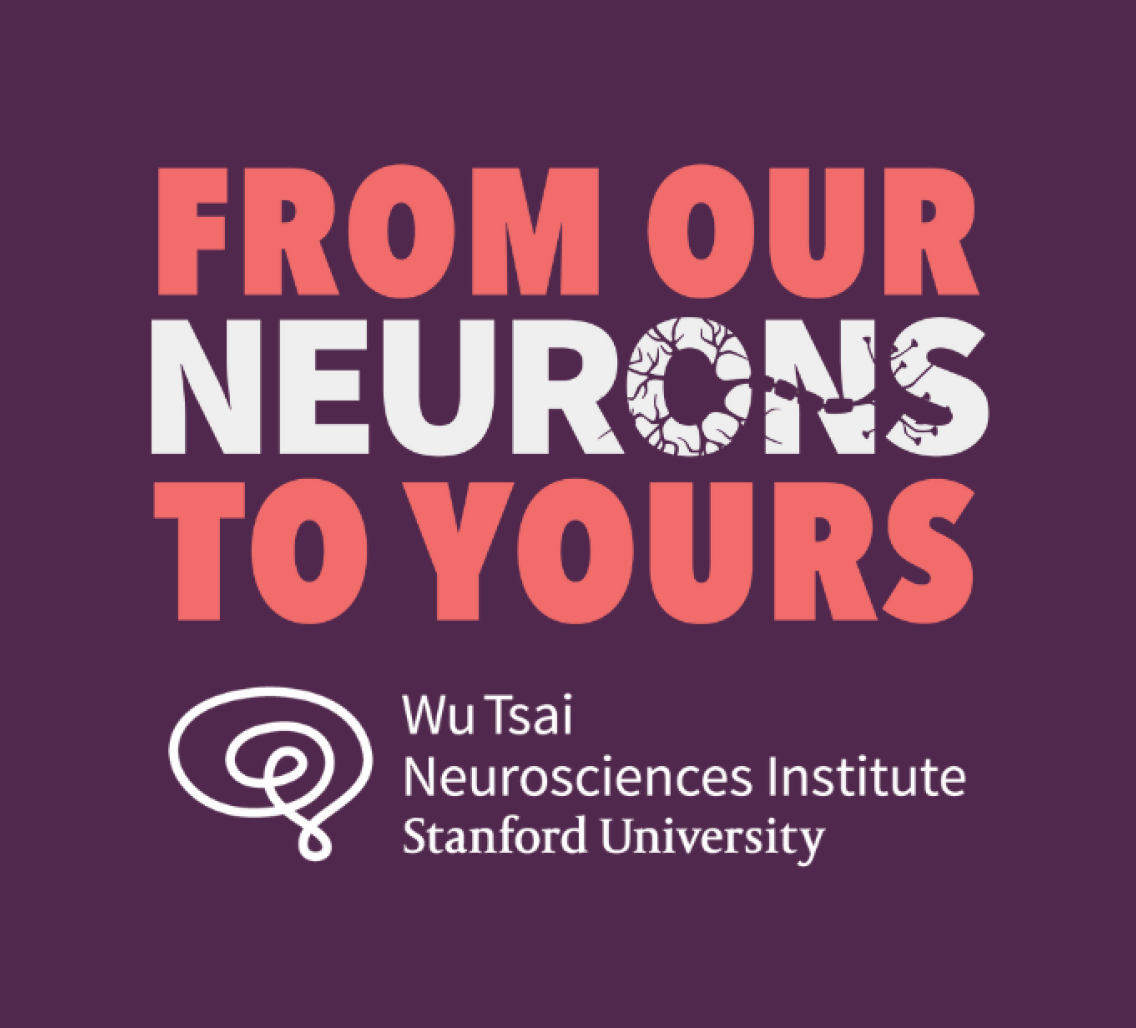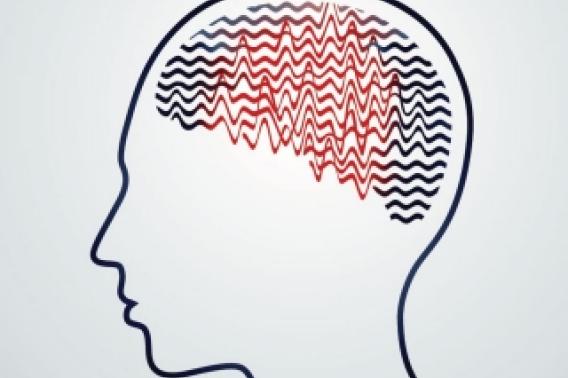An electrical storm in the brain

Imagine an electrical storm in your brain, a power surge that passes through delicately wired neural circuits making thousands of cells all activate at once.
Depending on where it starts and where it travels in the brain, it could make your muscles seize up. It could create hallucinatory visions or imaginary sounds. It could evoke deep anxiety or a sense of holiness, or it could even make you lose consciousness.
This kind of electrical storm is what we call a seizure. If your brain is prone to seizures, we call it epilepsy.
This week we're joined by Fiona Baumer, a Stanford pediatric neurologist and researcher, to dive into this misunderstood and often stigmatized disorder. In addition to treating children with seizure disorders, Dr. Baumer conducts research at the Koret Human Neurosciences Community Laboratory at Wu Tsai Neuro. There she uses transcranial magnetic stimulation (TMS) paired with EEG, to stimulate and read out patterns of activity moving across the brain in children with epilepsy.
In our conversation, we discuss what neuroscience has taught us about where seizures come from and how new technologies are giving us insights not only into potential treatments for the disorder, but also providing a window into some of the brain's hidden patterns of activity.
SUBSCRIBE on Apple Podcasts, Spotify, Google Podcasts, Amazon Music or Stitcher. (More options)
Learn more
Episode Credits
This episode was produced by Michael Osborne, with production assistance by Morgan Honaker, and hosted by Nicholas Weiler. Cover art by Aimee Garza.
We're taking a break over the next few weeks. We'll return with new episodes in the new year.
In the meantime, if you're enjoying our show, please take a moment to give us a review on your podcast app of choice and share this episode with your friends. That's how we grow as a show and bring the stories of the frontiers of neuroscience to a wider audience.
Episode Transcript
Nicholas Weiler:
This is From Our Neurons to Yours, a podcast from the Wu Tsai Neurosciences Institute at Stanford University. On this show, we crisscross scientific disciplines to bring you to the frontiers of brain science. I'm Nicholas Weiler.
Our brains are elaborate electrochemical organs whose billions of cells communicate through pulses of electrical current and puffs of molecular signals, but even small defects in how these circuits are wired or just the right intensely triggering stimulus can throw this delicate balance of electrochemical activity into overdrive. Imagine an electrical storm in your brain, a power surge that passes through delicately wired neural circuits making thousands of cells all activate at once.
Depending on where it starts and where it travels in the brain, it could make your muscles seize up. It could create hallucinatory visions or imaginary sounds. It could evoke deep anxiety or a sense of holiness, or it could even make you lose consciousness. This kind of electrical storm is what we call a seizure. If your brain is prone to seizures, we call it epilepsy. This week we're diving into this misunderstood and often stigmatized disorder to learn what neuroscience has taught us about where seizures come from and how new technologies are giving us insights not only into potential treatments for the disorder, but also providing a window into some of the brain's hidden patterns of activity. And that brings us to today's guest.
Fiona Baumer:
My name is Fiona Baumer. I am an assistant professor in neurology and neurologic sciences here at Stanford, and I work at Lucille Packard Children's Hospital taking care of children with epilepsy.
Nicholas Weiler:
Dr. Baumer is a clinician and researcher. In her lab, she uses transcranial magnetic stimulation, which we've talked about on the show before. TMS allows noninvasive targeted activation of brain circuits. Dr. Baumer pairs TMS with EEG, which allows her to stimulate and read out patterns of activity moving across the brain in children with epilepsy. We discuss this and other frontiers in epilepsy research in our conversation today, but I actually started off by asking her to tell me just a little bit about the history of epilepsy and how it was understood or misunderstood before the advent of modern medicine.
Fiona Baumer:
So the term epilepsy comes from a Greek word meaning to seize, and in many different cultures across history, the sort of local term for epilepsy really is the falling down disease. Over centuries, people have interpreted epilepsy as often having either a divine or demonic origin, so something that's coming from God. And so in some quite rare instances, people with epilepsy were actually revered, and actually some of our famous religious icons were thought to [inaudible 00:03:23] epilepsy, including some of the apostles and people like Joan of Arc. Additionally, or probably more commonly I should say, people with epilepsy were thought to have been taken by a demon. And so it was thought to be sort of a possession or demonic possession.
And even in the 19th century, people with epilepsy were often sent to asylums or to colonates, and so really we're excluded from society. That stigma, I think continues even now. When you see somebody have a seizure, it can be a really frightening thing. People look very different. They become very contorted. They often have different muscles stiffening and just like that original meaning of the word, many people fall and so they can hurt themselves quite severe. Once you'd had a stroke, you might have weakness that's there all of the time. With epilepsy, you can seem completely fine in between seizures and then quite suddenly have these really different motor symptoms quite frightening to those observing.
Nicholas Weiler:
Yeah, and so you could imagine why people might interpret those scary moments as being seized or possessed by something else because it doesn't seem to be them anymore. So I'd love to hear what we know today about what is actually going on. Obviously, epilepsy is not caused by some sort of spiritual possession. What do we know about what's going on in the brain? I've heard seizures be referred to as an electrical storm in the brain. Is that an accurate description?
Fiona Baumer:
I think it actually is a fairly accurate description. What we [inaudible 00:04:58] is epilepsy is not one thing, and people fight about the definition with great vigor, but it's a category of disorders that are characterized by your predisposition to have seizures. And so a seizure is an electrical storm in the brain. I want to be clear, any brain is capable of having a seizure. 10 to 20% of us in our life will have a seizure.
Nicholas Weiler:
Wow.
Fiona Baumer:
And so if you give us the right stimulation, if someone goes under electrical shock therapy or has diabetes and their blood sugar goes really low or they get the meningitis or they have a drug exposure, any of us have the capability of having a seizure, but epilepsy is the ability to sort of do that spontaneously. Epilepsy, as I said, encompasses many things, and so for some people it's the response to an injury where the brain becomes hyperexcitable around that site of injury. So whether that's a stroke or a traumatic brain injury or a tumor or something that's growing there, that can be a nidus for seizures.
Nicholas Weiler:
A nidus means a stimulus or a trigger.
Fiona Baumer:
It can be sort of a site where seizures can come from, like an origin point of seizures. Some people will have genetic changes that affect many cells in their brain and specific cells because they have more or less of, for example, a specific ion channel will be more likely to have seizures because of that. Other people can be born with certain structural problems. So for example, that can be a part of your cortex, which doesn't form normally. So the cells are different, and we see that a lot in our pediatric patients.
Nicholas Weiler:
So it sounds like there are many reasons why someone could experience epilepsy from a structural issue with the way their brain developed or something at the molecular level that's throwing off the way that the circuits behave. But all of these things lead to the tendency to have seizures at some frequency. How do we define a seizure? What's actually going on when the seizure is occurring?
Fiona Baumer:
Usually what we think of just coming back to your electrical storm analogy is that the excitation inhibition balance in the brain has been disrupted. Normally, we want our neurons to often be doing different things. We want the visual parts of our brain to be paying attention to the environment and the temporal, auditory parts to be listening. That's basically why we can walk and talk at the same time. In epilepsy, a group of neurons gets together and starts firing in a synchronized pattern. And when we think about focal seizures, we think about those neurons happening in one part of the brain. And for many of these patients, when you have that focal set of discharges, you might have symptoms that are very specific to that part of the brain region. For example, if it's coming from your [inaudible 00:07:34] cortex, you might start to have twitching of a hand.
If it's coming from parts of the brain more important for memory or language, you might have a sudden inability to talk. Those focal seizures can then spread to involve bigger networks, and usually when they hit the middle of the brain, the thalamus and that brainstem can cause alteration or loss of consciousness. In contrast, there are people who have what we call generalized seizures where we think of both halves of the brain getting involved almost instantaneously. For those patients, there's almost always alteration and consciousness immediately at the onset of the seizure. Those types of seizures can present sort of like the seizures we see on TV with the big shaking events or with something even much more subtle like a staring episode. So one of the most common types of seizures and epilepsies we see in children, something called childhood absence epilepsy, where children will just suddenly stop what they're doing and stare and then a few seconds later come back. And that can happen tens to hundreds of times a day.
Nicholas Weiler:
Wow, that's a lot. Okay, so epilepsy is someone who has a brain that is prone to seizures, and seizures can be very different in different people, but ultimately it has something to do with a bunch of neurons, whether in a small area or across the brain that start firing uncontrollably, and that can result in a motor issue where the muscles are spasming. It could result in a loss of consciousness, as you mentioned, depending on what parts of the brain are affected. Is that basically the idea?
Fiona Baumer:
That is the idea, and I think focal seizures actually have given us a lot of insight into what different parts of the brain do. So even in the 1800s, we talk about the Jacksonian march, which is the spread of a focal seizure down the motor cortex and the shaking, sort of moving from one part of the arm down to the hand. But we also have learned about deeper parts of the brain. For example, the insula, which is sort of the most folded and protected part, sort of between the bigger lobes of the brain. People who have seizures from there sometimes have choking sensations that wake them up from sleep. So different parts of the brain kind of give us different hints when they get involved in a seizure.
Nicholas Weiler:
Right. Well, I definitely want to come back to that point. One thing that strikes me as we talk about all these different kinds of epilepsy is that probably most people when they hear epilepsy or seizures are going to be thinking about this sort of classic motor seizure where there are spasms and the person loses control of their body. But there are really lots of different kinds of seizures as you've been describing. It's almost as if it's many different disorders that share some common physiology in the brain. Given the diversity of these things, how useful is this term epilepsy of lumping them all together? What is it that they have in common that makes that helpful?
Fiona Baumer:
Well, it's funny because in neurology talk about lumpers and splitters, that is sort of how we think about classification.
Nicholas Weiler:
So lumpers like to put everything in one category and splitters like to break it down into the most categories possible.
Fiona Baumer:
Exactly. And I think that epilepsy as a category, there's a few things that are probably helpful about it from a social perspective. One is that because it's recognized, I think it gives you at least a sense of diagnosis. One of the interesting things we've found, because really the sort of research and technology into genetics, into neuroimaging over the last 20 years has vastly improved our ability to be splitters, to understand a specific etiology that might be the cause of a person's epilepsy. What we found is that people having the diagnosis, even if you can't do something particularly helpful medically, sort of having that identification, having the community that comes along with it can be very helpful.
Well, that doesn't say why epilepsy as an umbrella term is useful. I think that it is important for people to understand sort of the category of that disease, but I think that sort of moving forward and thinking about how do we help people who have epilepsy? We can't think of them as one group. We have to sort of think about the individual etiologies, because I think as you're talking about, it's these neural networks that get involved, and depending on where seizures come from, depending on the type of epilepsy you have, different networks will be more heavily disturbed. And so for all patients really trying to understand as much as we can and as specific and personalized as we can, we'll hopefully continue that process of making therapeutic advances.
Nicholas Weiler:
Yeah, we've been talking a lot about what we know and defining what epilepsy is. Some of these things I think have probably been known by the medical community for a long time. So I'd love to dive in with you to talk about what are some of the things we've been learning most recently, and use that to dive a little bit more deeply into your own work, understanding the consequences of epilepsy in the brain. I understand there's been a lot of genetics recently. I think you mentioned this earlier, we're starting to learn some of the genetic predisposing factors that might make brain circuits particularly susceptible to these runaway trains of activity in the brain.
Fiona Baumer:
Yeah, so I think in terms of genetics, since the human genome project finished in 2003, we've seen really a revolution in how genetics are applied to individual patients. Early genetic studies in epilepsy and sort of the first 10 years of this century really focused a lot on very severe epilepsy phenotypes. And I think that's actually brought out a lot of the information identifying specific genes. For example, the SCN one, a gene, which has been first identified in people with Dravet syndrome, and then there's something called generalized epilepsy with febrile seizures plus. So these family epilepsies where they could test many members and find a single gene that was highly penetrant or a gene where just one person had it and the rest of the family did not have the epilepsy. And so they were really able to drill down and identify a number of genes.
At this point, we have gene panels for epilepsy patients that are over 300 genes included as a simple saliva test. So that's been an area where research has really jumped into clinical practice very quickly. With next generation sequencing that allowed these type of panels it also has allowed us to look at the entire coding region of the genome. So we do something called whole exome sequencing. In the last year that's been recommended as a general practice for anyone with epilepsy of an unclear etiology.
Nicholas Weiler:
That's amazing. You can now just get the genetics really for anyone who needs it. In the past few decades, we've also had access to brain recordings from the brains of people living with epilepsy using implanted electrodes. And this is something I think is really fascinating because it gives a really unparalleled window into how brain circuits are functioning. So I'd love to hear a little bit more about what are we learning about what is going on in the brain of people with epilepsy from some of these new technologies?
Fiona Baumer:
So I think that one of the bigger deals in epilepsy treatment in the last 10 years has been our neurostimulation devices, and particularly the devices like the responsive neurostimulation system or RNS that could actually record activity over the long period. So in general, we've gained a lot of insight into what specific regions of the brain participate in a variety of both just general tasks such as language processing or emotion by looking at patients with epilepsy, with implanted electrodes who come to the hospital for surgery. So one third of patients require something other than medications to treat their seizures. If you have focal epilepsy, particularly we try to see if surgery is a good option. And for those patients where it's not a good option, because even the area is a really functionally important one, like it would control your hand movement. Or sometimes when you have bilateral seizures in areas that are important, such as the hippocampi where we know that you require that in order to have short-term memory consolidation, that's when we've been using devices like the RNS to record data and to use that data to stimulate.
Nicholas Weiler:
So we can now detect when a seizure is starting and stimulate right away to do something to interrupt it, is that what I'm hearing?
Fiona Baumer:
Yeah, that's the concept of the RNS. It's that it's measuring activity, and there's a computer that sort of sits in a box in your skull that is analyzing it and is taught to recognize specific patterns and to give stimulation at the time of that pattern onset.
Nicholas Weiler:
That's incredible.
Fiona Baumer:
So with these devices, we're learning a lot. I think they've mostly focused on trying to understand sort of what patterns predict the onset of seizures. But what we've also learned, for example, is that by treating seizures and also by providing with stimulation, probably at times when abnormal electrical activity is occurring, but it wouldn't necessarily turn into a seizure, we can do things like we can adjust attention. So patients who have had hippocampal leads have been shown to have an improvement in verbal memory. In those who have neocortical leads, so in sort of the, for example, the motor cortex or other occipital cortex, they seem to have improvements in naming tasks. So a language task. This has given as insight into just the effects of a disorder and as abnormal activity on your ability to do these sort of normal function.
Nicholas Weiler:
Right. So suddenly you're eliminating these seizures and people's functionality is improving, just revealing how much the seizures were already doing to impair that.
Fiona Baumer:
It's a really big impetus to sort of keep working towards not only just stopping seizures, but trying to help normalize this activity as much as possible in terms of being able to help patients have their best outcomes. My research focuses on the cognitive comorbidities of epilepsy because unfortunately, approximately 50% of children who have seizures will also have some type of issues with language or attention. And I'm really interested in trying to understand why that occurs. My research takes place in the core community lab. Here at Wu Tsai, there I have access to really incredible equipment, including transcranial magnetic stimulation, which is a way where we can non-invasively, stimulate the brain and understand sort of what it's doing at any point in time, as well as modify brain signals for a period of time.
And then we also use the EEG equipment to monitor brainwaves, both when people are doing things like language shots, and also while we're doing that TMS. And that gives us a sense of what the brain is doing with really millisecond resolution. So in my research, I have children with the most common focal epilepsy. It's something called self-limited epilepsy with central temporal spikes. These are children who have seizures that come from motor regions mostly at night, and most of their abnormal activity, we can tell it happens when they're asleep. They seem to have some issues with cognition and particularly with language. And so what we're trying to do is try to understand why these motor cortex seizures are interfering with language network development, and we're using TMS as a tool to do that.
Nicholas Weiler:
Wonderful. Well, I'd love to hear so much more about this. This is obviously a really burgeoning area of study, particularly with new technologies that we have the ability to stimulate and record from the brain. I'm afraid that we're out of time, but thank you so much for talking with us about your work and about the history of this field.
Fiona Baumer:
Thank you. It was my pleasure.
Nicholas Weiler:
Thanks so much again to our guest, Fiona Baumer. You can learn more about her research in the show notes.
We're taking a break over the next few weeks. We'll return with new episodes in the new year. In the meantime, if you're enjoying our show, please take a moment to give us a review on your podcast app of choice and share this episode with your friends. That's how we grow as a show and bring the stories of the frontiers of neuroscience to a wider audience.
This episode was produced by Michael Osborne with Production Assistance by Morgan Honaker. I'm Nicholas Weiler. See you next time.



